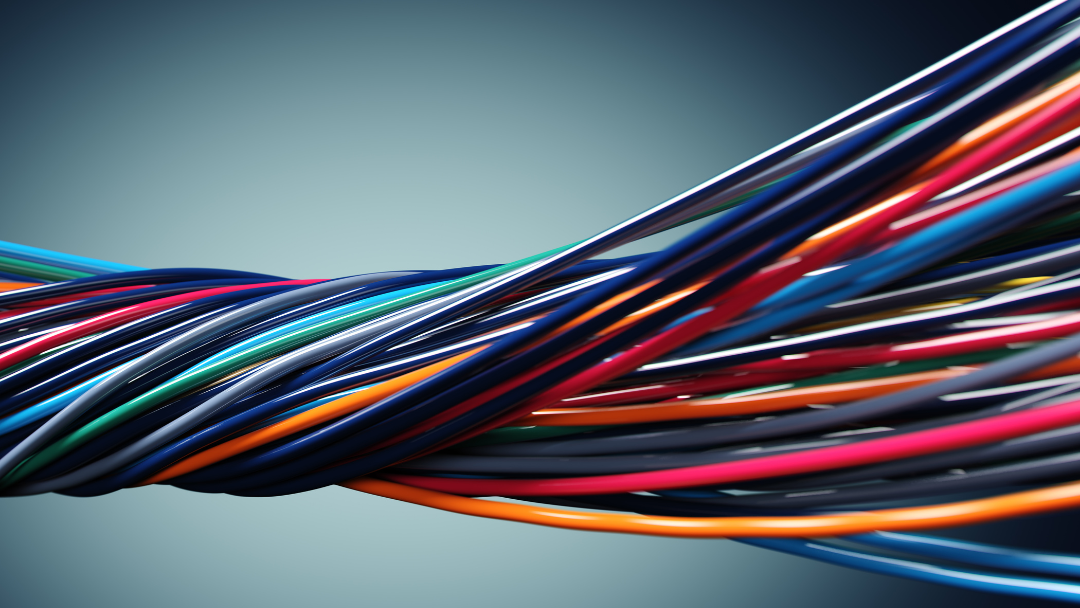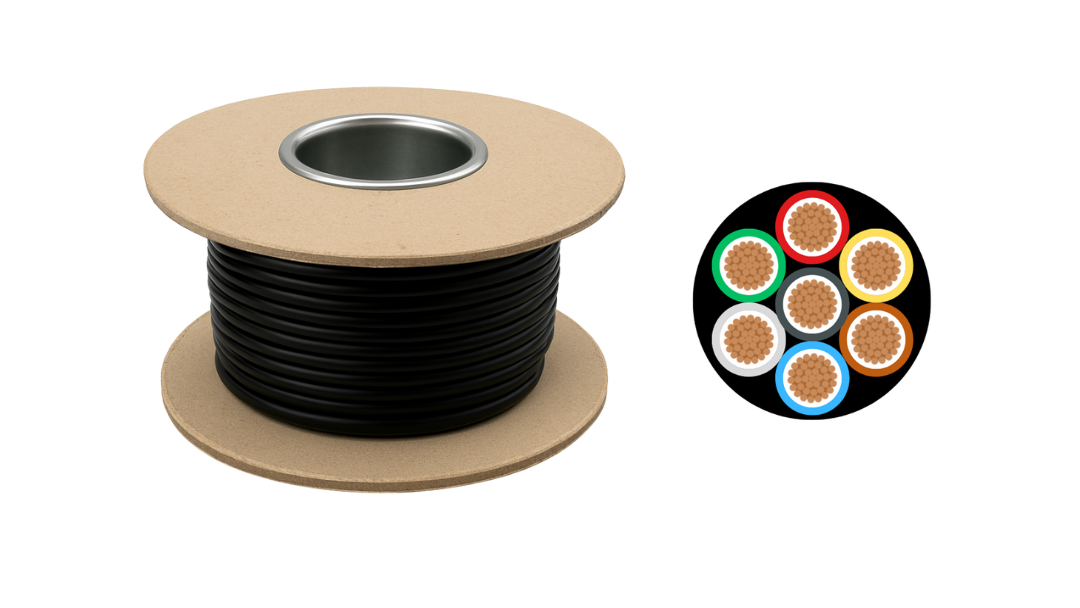Whether you're a mechanic or procurement specialist, knowing how to read automotive cable specifications is the secret to a successful installation. The right cable ensures safety, reliability and performance, especially in today's complex systems.
In this short guide, we'll cut through the technical jargon and explain how to read cable labels with practical, real-world examples.
→ Shop our Automotive Cable Range now

Breaking down the specs
The world of cable specifications doesn't have to be confusing – not when you understand key terminology. The following sections clarify phrases you'll hear time and time again in the automotive industry.
Cross-sectional area (mm² or AWG)
A cable's cross-sectional area, measured in square millimetres (mm²) or American Wire Gauge (AWG), refers to the thickness of the conductive core – not the overall diameter of a cable, which includes insulation and protective layers.
Why is the cross-sectional area important? Basically, it determines how much electrical current a wire can safely carry. The larger the cross-sectional area, the more power it can handle without overheating.
Thicker wires are ideal for heavy-duty applications that demand large amounts of current, such as connecting an EV battery to its motor controller.
Voltage rating
Voltage rating refers to the maximum voltage a cable can handle under normal operating conditions.
Choosing an appropriate voltage rating guarantees reliable performance while minimising unnecessary increases in cost, size and weight. Think of voltage like a water hose – if the water pressure (voltage) is too high, the hose (cable) might burst.
Temperature rating
The temperature rating defines the range of temperatures a cable can operate within without compromising performance.
It's typically divided into two parts: the maximum operating temperature and the minimum installation temperature.
- Maximum operating temperature is the highest temperature a cable can handle without melting or cracking.
- Minimum installation temperature is the lowest temperature a cable can handle without damaging the insulation.
Insulation types
Different insulation types serve specific purposes, so it's essential to know exactly what you're getting. Here are five of the most common:
- PVC (polyvinyl chloride) – A versatile insulation used in general-purpose wiring for low- to medium-temperature environments.
- XLPE (cross-linked polyethylene) – Offers excellent thermal, chemical and mechanical resistance, making it ideal for high-heat zones.
- Silicone — Highly flexible and commonly used to withstand moving parts.
- TPE (thermoplastic elastomer) – Known for its high heat resistance (up to 250°C), so well suited for engine bays and EV power systems.
- ETFE (Ethylene Tetrafluoroethylene) – A premium insulation with outstanding heat, chemical and abrasion resistance, typically used in aerospace and high-performance automotive systems.
Related reading: A Quick Guide to Cable Covers & Protectors
Number of strands
The number of strands refers to how many individual copper wires are twisted together to form a single conductor. More strands mean greater flexibility, which is important when wiring moving parts and vibration-prone areas.
Colour coding
Automotive cables have different outer insulation colours depending on their function, which reduces wiring errors. Since colour codes vary between manufacturers and regions, it’s important to check the supplier’s instructions before starting work.

Durability and environmental resistance
In real-world automotive environments, a cable’s ability to withstand harsh conditions can be just as important as its electrical performance. When reviewing specifications, look beyond voltage and current ratings to check for durability features that match your installation area.
- Oil resistance – Essential for wiring in or near the engine bay, where exposure to engine oil, transmission fluid or brake fluid is common. Without oil-resistant insulation, cables can swell, crack or degrade over time.
- UV resistance – Any cable exposed to direct sunlight should be UV-stabilised. That includes wiring routed in convertibles or exterior-mounted systems, for example. This prevents brittleness and premature failure caused by prolonged sun exposure.
- Abrasion protection – Wires running through tight spaces, around sharp edges or near moving components need abrasion-resistant insulation or additional sleeving. This reduces the risk of cuts and shorts.
- Moisture resistance – Water ingress is a leading cause of electrical faults. Moisture-resistant insulation is critical for cables exposed to rain, car washes or road spray. In some cases, sealed connectors and grommets are used in combination with specialised insulation to ensure reliability.
How to read a cable label
It's time to put everything we've learnt in this guide into practice. Let's break down the following cable specification as an example:
35mm² PVC 600V red battery cable
- 35mm² – the cross-sectional area of the conductor
- PVC – the insulation material
- 600V – the maximum voltage it can safely handle
- Red – the insulation colour, often used for positive battery leads
- Battery cable – indicates the cable’s intended use
Here’s a slightly more complex example:
16 AWG XLPE 125°C shielded twisted pair
- 16 AWG – conductor size (about 1.3 mm² cross-sectional area)
- XLPE – insulation type, offering good thermal and chemical resistance
- 125°C – maximum operating temperature rating
- Shielded – the cable has a layer of foil or braid to protect against electromagnetic interference (EMI), making it suitable for sensitive electronics
- Twisted pair – two conductors twisted together to reduce signal noise, commonly used for data or communication lines in vehicles
Practical tips for selection
With so many specifications to consider, it helps to have a structured approach when choosing automotive cables. The following checklist will guide you through the key questions every mechanic, engineer or procurement specialist should ask:
-
What’s the operating voltage?
Match the cable’s voltage rating to your system. Using an underrated cable can lead to breakdowns, while overspecifying adds unnecessary cost and weight.
-
How much current is drawn?
Check the expected current and choose a cable with the right cross-sectional area and ampacity. Undersized cables overheat and become a safety hazard.
-
What’s the environment?
Consider factors like heat, vibration, abrasion, oil exposure and moisture. Under-the-bonnet wiring requires different insulation and protective measures compared to interior cabin circuits.
-
Is flexibility important?
For areas with frequent movement choose cables with more strands or silicone/TPE insulation. This includes doors and seats. For static connections, such as battery leads, a stiffer cable may be acceptable.
Decision-making tip:
Think of cable selection as a balancing act between safety, performance and cost. By running through these questions before ordering, you’ll avoid the two biggest mistakes – paying too much for unnecessary features, or cutting corners on a cable that won’t last.
Choose the right cables for your project
As a rule: When in doubt, check the spec. Understanding automotive cable specifications will ensure you always deliver the highest-quality work, free from expensive and time-consuming hiccups.
If you need more advice on cable management, contact our team today.


